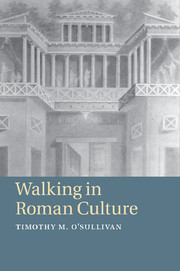Book contents
- Frontmatter
- Contents
- Figures
- Acknowledgements
- Abbreviations
- Introduction
- Chapter 1 The art of walking
- Chapter 2 Seneca on the mind in motion
- Chapter 3 Urban walkers on display
- Chapter 4 Cicero’s legs
- Chapter 5 Theoretical travels
- Chapter 6 Walking with Odysseus
- Conclusion
- Bibliography
- Subject index
- Index locorum
Chapter 6 - Walking with Odysseus
Published online by Cambridge University Press: 05 August 2011
- Frontmatter
- Contents
- Figures
- Acknowledgements
- Abbreviations
- Introduction
- Chapter 1 The art of walking
- Chapter 2 Seneca on the mind in motion
- Chapter 3 Urban walkers on display
- Chapter 4 Cicero’s legs
- Chapter 5 Theoretical travels
- Chapter 6 Walking with Odysseus
- Conclusion
- Bibliography
- Subject index
- Index locorum
Summary
The elite Romans living in the elaborately decorated villas and town houses of the late republic and early empire were constantly confronted with an optical illusion. The walls of their houses were typically covered with paintings that consistently challenged the viewer to look both at the wall and through it, whether onto an imaginary garden, or at a famous scene from Greek mythology, or into a receding abyss of architectural forms. Nor was the illusion restricted to the decoration only: just as painted architectural features could frame artificial views, real architectural elements could frame real views, whether out onto the surrounding countryside – if one was lucky enough to be in a country villa – or onto other areas within the house itself. Lines of sight might be carefully arranged so as to call into question the very distinction between real and artificial views; this constant interplay of views both fictive and real in the Roman house is a reflection of what Bettina Bergmann has called the “desire to blur the line between vision and representation.”
The subject of this chapter is a well-known example of just this sort of visual play: the Roman fresco known as the Odyssey Landscapes (Figs. 1–5). Unlike contemporary paintings of the mid first century bce, in which either figural or architectural subjects dominate, the fresco is famous for its emphasis on natural forms: rocks, cliffs, crags, bays, caves, trees, islands, and ocean all compete for the viewer’s attention. In the midst of this dramatic natural setting are miniature figures enacting scenes from the Homeric Odyssey: specifically, from the part of the Odyssey narrated by Odysseus himself, including his encounter with the Laestrygonians and with Circe, the nekuia, and the voyage past the Sirens.
- Type
- Chapter
- Information
- Walking in Roman Culture , pp. 116 - 149Publisher: Cambridge University PressPrint publication year: 2011

